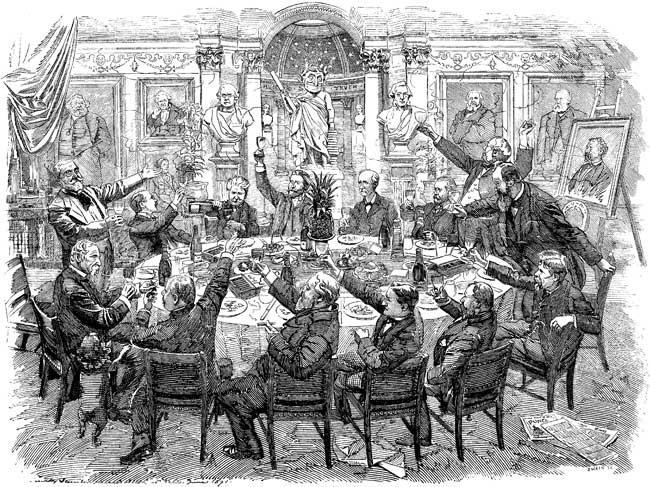An important aspect of Allan’s Miscellany, the fictional magazine in my new series, is the weekly staff dinner on Wednesday nights. The dinner will be first mentioned in the second volume, where (unlike in The Bride Prize) the staff of Allan’s actually consists of more than two people. This is the relevant snippet:
In the courtyard of Allan and Sons, the lanterns had already been lit Jack saw, as he strode towards the stars that led to the open upper gallery. When he pushed open the door at the end of the short passage, warm, mellow light spilled from the room, and Jack was greeted by the sounds of male voices and laughter.
This was ‘the Den,’ the editorial office of Allan’s Miscellany, whereat the large table dominating the room, a magazine was fashioned week after week, where flame-haired William MacNeil ruled his crew of writers and artists with an iron fist. It was here that the staff assembled on Wednesday nights to discuss the next issue over an opulent dinner sponsored by their publisher. After all, Uncle Allan had argued, Fraser’s had a dinner and Punch had a weekly dinner, too — and what was good enough for them was certainly good enough for Allan’s!
As you can see from this snippet, not just my inner history geek, but also my somewhat obsessive love for Punch are coming to the fore again. The aspect of community is something I find extremely fascinating about the history of nineteenth-century periodicals in general and the history of Punch in particular. Community was as important to Victorian writers as it is to writers today — or perhaps even more so: in some cases the very survival of a writer / artist and his family depended on the charity of his colleagues. Dickens, for example, often organised amateur theatricals for the benefit of a colleague or his family.
But also in their normal everyday lives and their work, community and personal relationships were important to the journalists of the time. One editor had the habit of leafing through rivaling periodicals, and whenever he saw a negative review of a friend’s book or a negative article about a friend, he would immediately insert a passionate rebuttal into his own magazine. Dickens broke with Bradbury & Evans, his publishers, because Punch (also published by Bradbury & Evans) had refused to print his open letter to the public, in which Dickens explained the reasons for his separation from his wife.
For some magazines, the communal factor became relevant even when producing the magazine: as mentioned in the snippet above, the inner staff of Punch met for weekly dinners (on Wednesday nights, of course *g*), where they discussed the topic and motif for the next issue’s large cut, the central one-page political cartoon. The Punch dinners were legendary; in a way, they were one of the most exclusive gentlemen’s clubs in London: you could only attend upon invitation from the editor.
Below you can see an idealized depiction of the Punch Table from the 1890s, with Francis Burnand (editor from 1880-1890) on the left, making the toast of the evening. To his right sits Sir John Tenniel, who illustrated Lewis Carroll’s Alice in Wonderland books and had become a member of the staff of Punch in 1850. Dominating the background is a sculpture of Mr. Punch himself, and on the walls you can see portraits and busts of late staff members (e.g., the portrait of Mark Lemon, the first editor, is on the left; the bust on the left is Thackeray and the bust on the right is John Leech, the artist).
In my series, I use the weekly dinners to introduce readers to the staff of Allan’s, to depict the sense of community that binds these men together, and to show the development of the magazine: as the magazine grows in importance, so do the numbers of writers and artists. The dinners are also a great opportunity for me to plant Easter eggs and running jokes like Matthew Clark’s whoopee cushion. The following is another snippet from Falling for a Scoundrel, the second volume in the series (aka the WIP I was supposed to finish by the end of May *cue in manic laughter*)
“Jack! There you are!” Matthew Clark — theatre and literature — shouted. “You won’t believe what I’ve found in that curiosity shop I told you about!”
Behind him Lawrence Pelham, comic artist, emphatically shook his head. Do not ask! he voiced silently.
“It’s the most splendid thing!”
Gervase Carlton, who covered general news as Mr. Copperwit, smirked. “Knowing our Matt, I say he’ll inflict that thing upon us for years to come.”
“Thing?” Jack echoed, his brows raised. Having shed his heavy coat, he sank down onto his chair — which bleated like a dying goat.
Jack jerked upright, his hand on the knife he carried hidden at his side.
Matt grinned delightedly. “See? You’ve found it! It’s a whoopee cushion. Isn’t it the most splendid thing?”
Taking a deep breath, Jack let his hand fall to his side and reminded himself that his colleague couldn’t possibly know how close his precious new whoopee cushion had come to being separated from its whoopee forevermore.
~ Sandy


